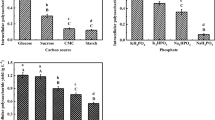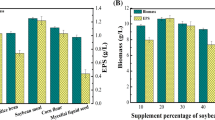Abstract
The aim of this study was to optimize the culture medium used for the mycelial growth and production of intracellular polysaccharides (IPS) and exopolysaccharides (EPS) in a submerged culture of Hericium erinaceum. Of the various factors examined, including carbon and nitrogen sources, vitamins, mineral elements, and initial pH, those that proved to have a significant effect were then tested using a 24 central composite rotatable design (CCRD). Under the optimal culture conditions, the maximal yield of biomass reached 14.24 ± 0.45 g l−1 and was 1.85-fold higher than in the basal medium. The kinetics of EPS biosynthesis in a bioreactor showed that although the highest yield of EPS (2.75 ± 0.27 g l−1) could be obtained on day 8, the process of biosynthesizing high molecular weight polysaccharides proceeded until the depletion of the carbon source in the medium (after 14 days of cultivation). Our results could be very helpful in the large-scale production of bioactive polysaccharides from H. erinaceum.






Similar content being viewed by others
References
Chen W, Zhao Z, Chen SF, Li YQ (2008) Optimization for the production of exopolysaccharide from Fomes fomentarius in submerged culture and its antitumor effect in vitro. Bioresour Technol 99:3187–3194. doi:10.1016/j.biortech.2007.05.049
Cho EJ, Oh JY, Chang HY, Yun JW (2006) Production of exopolysaccharides by submerged mycelial culture of a mushroom Tremella fuciformis. J Biotechnol 127:129–140. doi:10.1016/j.jbiotec.2006.06.013
Dubois M, Gilles KA, Hamilton JK, Rebers PA, Smith F (1956) Colorimetric method for the determination of sugars and related substances. Anal Chem 28:350–358. doi:10.1021/ac60111a017
Elibol M (2004) Optimization of medium composition for actinorhodin production by Streptomyces coelicolor A3(2) with response surface methodology. Process Biochem 39:1057–1062. doi:10.1016/S0032-9592(03)00232-2
Fan L, Pan H, Soccol AT, Padney A, Soccol CR (2006) Advances in mushroom research in the last decade. Food Technol Biotechnol 44:303–311
Hsieh C, Tsai MJ, Hsu TH, Chang DM, Lo CT (2005) Medium optimization for polysaccharide production of Cordyceps sinensis. Appl Biochem Biotechnol 120:145–157. doi:10.1385/ABAB:120:2:145
Hsieh C, Tseng MH, Liu CJ (2006) Production of polysaccharides from Ganoderma lucidum (CCRC 36041) under limitations of nutrients. Enzyme Microb Technol 38:109–117. doi:10.1016/j.enzmictec.2005.05.004
Huang D, Cui F, Li Y, Zhang Z, Zhao J, Han X, Xiao X, Qian J, Wu Q, Guan G (2007) Nutritional requirements for the mycelial biomass and exopolymer production by Hericium erinaceus CZ-2. Food Technol Biotechnol 45:389–395
Joo JH, Lim JM, Kim HO, Kim SW, Hwang HJ, Choi JW, Yun JW (2004) Optimization of submerged culture conditions for exopolysaccharide production in Sarcodon aspratus (Berk.) S. Ito TG-3. World J Microbiol Biotechnol 20:767–773. doi:10.1007/s11274-004-5841-x
Kim HO, Lim JM, Joo JH, Kim SW, Hwang HJ, Choi JW, Yun JW (2005) Optimization of submerged culture condition for the production of mycelial biomass and exopolysaccharides by Agrocybe cylindracea. Bioresour Technol 96:1175–1182. doi:10.1016/j.biortech.2004.09.021
Kumari M, Survase SA, Singhal RS (2008) Production of schizophyllan using Schizophyllum commune NRCM. Bioresour Technol 99:1036–1043. doi:10.1016/j.biortech.2007.02.029
Li J, Li P, Liu F (2008) Production of theanine by Xerocomus badius (mushroom) using submerged fermentation. LWT-Food Sci Technol 41:883–889. doi:10.1016/j.lwt.2007.05.020
Lin ES, Sung SC (2006) Cultivating conditions influence exopolysaccharide production by the edible basidiomycete Antrodia cinnamomea in submerged culture. Int J Food Microbiol 108:182–187. doi:10.1016/j.ijfoodmicro.2005.11.010
Malinowska E, Krzyczkowski W, Herold F, Łapienis G, Ślusarczyk J, Suchocki P, Kuraś M, Turło J (2009) Biosynthesis of selenium-containing polysaccharides with antioxidant activity in liquid culture of Hericium erinaceum. Enzyme Microb Technol 44:334–343. doi:10.1016/j.enzmictec.2008.12.003
Miller GL (1959) Use of dinitrosalycilic acid reagent for determination of reducing sugars. Anal Chem 31:426–430. doi:10.1021/ac60147a030
Mizuno T (1995) Yamabushitake, Hericium erinaceus: bioactive substances and medicinal utilization. Food Rev Int 11:173–178
Mizuno T, Wasa T, Ito H, Suzuki C, Ukai N (1992) Antitumor-active polysaccharides isolated from the fruiting body of Hericium erinaceum, an edible and medicinal mushroom called yamabushitake or houtou. Biosci Biotechnol Biochem 6:347–348
Moradali MF, Mostafavi H, Ghods S, Hedjaroude GA (2007) Immunomodulating and anticancer agents in the realm of macromycetes fungi (macrofungi). Int Immunopharmacol 7:701–724. doi:10.1016/j.intimp.2007.01.008
Ooi VEC (2008) Structure and antitumor activity relationship of polysaccharides. In: Cheung PCK (ed) Mushrooms as functional foods. Wiley, Hoboken, pp 173–198
Ooi VEC, Liu F (1999) A review of pharmacological activities of mushroom polysaccharides. Int J Med Mushrooms 1:195–206
Park YS, Lee HS, Won MH, Lee JH, Lee SY, Lee HY (2002) Effect of an exo-polysaccharide from the culture broth of Hericium erinaceus on enhancement of growth and differentiation of rat adrenal nerve cells. Cytotechnology 39:155–162. doi:10.1023/A:1023963509393
Pokhrel C, Ohga S (2007) Submerged culture conditions for mycelial yield and polysaccharides production by Lyophyllum decastes. Food Chem 105:641–646. doi:10.1016/j.foodchem.2007.04.033
Reshetnikov SV, Wasser SP, Tan KK (2001) Higher Basidiomycota as a source of antitumor and immunostimulating polysaccharides (review). Int J Med Mushrooms 3:361–394
Revankar MS, Lele SS (2006) Enhanced production of laccase using a new isolate of white rot fungus WR-1. Process Biochem 41:581–588. doi:10.1016/j.procbio.2005.07.019
Shih IL, Pan K, Hsieh C (2006) Influence of nutritional components and oxygen supply on the mycelial growth and bioactive metabolites production in submerged culture of Antrodia cinnamomea. Process Biochem 41:1129–1135. doi:10.1016/j.procbio.2005.12.005
Shih IL, Tsai KL, Hsieh C (2007) Effects of culture conditions on the mycelial growth and bioactive metabolite production in submerged culture of Cordyceps militaris. Biochem Eng J 33:193–201. doi:10.1016/j.bej.2006.10.019
Tang YJ, Zhong JJ (2002) Fed-batch fermentation of Ganoderma lucidum for hyperproduction of polysaccharide and ganoderic acid. Enzyme Microb Technol 31:20–28. doi:10.1016/S0141-0229(02)00066-2
Tang YJ, Zhu LW, Li HM, Li DS (2007) Submerged culture of mushrooms in bioreactors—challenges, current state-of-the-art, and future prospects. Food Technol Biotechnol 45:221–229
Wang YX, Lu ZX (2004) Statistical optimization of media for extracellular polysaccharide by Pholiota squarrosa (Pers. ex Fr.) Quel. AS 5.245 under submerged cultivation. Biochem Eng J 20:39–47. doi:10.1016/j.bej.2004.04.004
Wasser SP (2002) Medicinal mushrooms as a source of antitumor and immunomodulating polysaccharides. Appl Microbiol Biotechnol 60:258–274. doi:10.1007/s00253-002-1076-7
Xu CP, Kim SW, Hwang HJ, Choi JW, Yun JW (2003) Optimization of submerged culture conditions for mycelial growth and exo-biopolymer production by Paecilomyces tenuipes C240. Process Biochem 38:1025–1030. doi:10.1016/S0032-9592(02)00224-8
Yang BK, Park JB, Song CH (2003) Hypolipidemic effect of an exo-biopolymer produced from a submerged mycelial culture of Hericium erinaceus. Biosci Biotechnol Biochem 67:1292–1298. doi:10.1271/bbb.67.1292
Zaidman BZ, Yassin M, Mahajna J, Wasser SP (2005) Medicinal mushroom modulators of molecular targets as cancer therapeutics. Appl Microbiol Biotechnol 67:453–468. doi:10.1007/s00253-004-1787-z
Acknowledgments
The authors would like to thank Professor Stewart A. Brown and Professor Alicja M. Zobel for their useful comments and for improving the language of the manuscript.
Author information
Authors and Affiliations
Corresponding author
Rights and permissions
About this article
Cite this article
Malinowska, E., Krzyczkowski, W., Łapienis, G. et al. Improved simultaneous production of mycelial biomass and polysaccharides by submerged culture of Hericium erinaceum: optimization using a central composite rotatable design (CCRD). J Ind Microbiol Biotechnol 36, 1513–1527 (2009). https://doi.org/10.1007/s10295-009-0640-x
Received:
Accepted:
Published:
Issue Date:
DOI: https://doi.org/10.1007/s10295-009-0640-x




